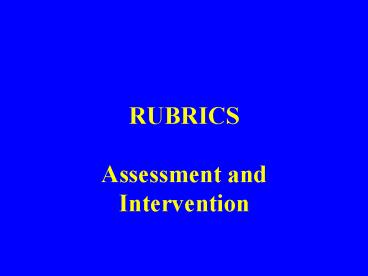RUBRICS - PowerPoint PPT Presentation
1 / 14
Title:
RUBRICS
Description:
Description of writing based upon certain qualities inherent to the piece ... 'Reading this paper is easy.' As complex as 'Do big errors shout at me from the page? ... – PowerPoint PPT presentation
Number of Views:672
Avg rating:3.0/5.0
Title: RUBRICS
1
RUBRICS
- Assessment and Intervention
2
A RUBRIC ARTICULATES
- Expectations for the Assignment
- Criteria or What Counts
- Levels of Quality
- from excellent to poor
3
HOLISTIC RUBRIC
- Wholistic evaluation
- First impression of the overall quality of the
writing - Domain Scoring Guide for the
- PSSA Writing Test
4
ANALYTIC RUBRIC
- Description of writing based upon certain
qualities inherent to the piece - Examination of the individual parts or elements
to look at the whole
5
Analytic Rubric used by the Teacher to
- Analyze students work.
- Assess students strengths and weaknesses in
writing and composing. - Create intervention tools for instruction.
6
Analytic Rubric used by the Teacher to
- Develop instructional rubrics for students.
- Teach necessary concepts through direct
instruction. - Evaluate and monitor students progress in
writing skills.
7
Analytic Rubric used by the Teacher to
- Conference with individual students
- Repeat instruction, if necessary.
- Move students to higher levels of writing skills.
8
Analytic Rubric used by the Students to
- Get a general sense of the undertaking.
- Set goals for their writing.
- Create plans for papers.
- Complete self-assessments.
9
Analytic Rubric used by the Students to
- Improve their personal writing styles and skills.
- Monitor their progress.
- Hopefully, feel more comfortable with their
writing.
10
Use Assessment as an Instructional Tool
- Students can generate their own scoring rubrics.
- Thus, student-prepared rubrics are grounded in
their own values and critical judgment.
11
ASSESSMENT through RUBRICS
- Define assessment for students
- in terms of
- feedback.
12
ASSESSMENT through RUBRICS
- Do not ask students to grade themselves.
- Teach students how to use rubrics to formally
assess their own writing.
13
YOUR TURN
- Create a scoring rubric specific to your domain
and group piece. - Define the trait for your domain.
- State the criteria needed to meet a certain
level. - Write your guide from one point of view (student
or teacher).
14
YOUR TURN
- Share your rubrics with the group.
- What interventions can you provide to move your
students from low scores to higher scores?
15
INTERVENTION
- Instructional Strategy
- Method to intervene or change poor writing
practices exhibited by students. - Teaching practice to develop improved student
skills so that students can achieve higher
levels.
16
INTERVENTION
- How can you, as the teacher, help your students
improve their writing? - Review individual assessments and select certain
targets as achievement goals.
17
INTERVENTION
- Develop interventions in the form of direct
instruction, student goals, collaborative
learning, models, planning, proofreading,
conferencing - Look at your rubrics.
18
INTERVENTION
- As simple as
- I want you to add three strong words to your
story. - Write as much as you can in 3 minutes.
- Circle the word said. Replace it with another
word.
19
INTERVENTION
- As complex as
- Look at the beginnings of your sentences. Do
they always start the same way? If so, I will
help you change some of those beginnings.
20
INTERVENTION
- As simple as
- Reading this paper is easy.
- As complex as
- Do big errors shout at me from the page?
21
YOUR TURN
- Within your small group, develop some
interventions for your domain area.
22
YOUR TURN
- Share your interventions
- with all of us.
23
YOUR TURN
- Develop some writing rubrics for and with your
students. - Assess your students progress.
- Devise interventions to improve their skills.
- Enjoy observing your students as they make
progress with their writing.
24
YOUR TURN
- Interpret the PSSA domain scoring guide.
- Create analytic rubrics.
- Develop interventions.
- Practice the Progress Monitoring Process.
- Write with students!
25
BIBLIOGRAPHY
- Assessment and Evaluation. http//www.sasked.gov
.sk.ca/docs/mla/assess.html 25 Feb. 2005. - Baldwin, Doug. A Guide Standardized Writing
Assessment, Educational Leadership. Oct. 2005
72-75.
26
BIBLIOGRAPHY
- Olson, Carol Booth. Practical Ideas for Teaching
as a Process at the Elementary and Middle School
Levels. California Department of Education 1996. - Saddler, Bruce and Heidi Andrade. The Writing
Rubric, Educational Leadership. October 2004
48-52.
27
RUBRIC RESOURCES
- http//rubistar.4teachers.org/index.php
- http//www.teach-nology.com/web_tools/rubrics/
- http//www.uen.org/Rubric/rubric.cgi?rubric_id108
2 - http//www.ncsu.edu/midlink/rub.pres.html































